What are the top 12 augmented reality trends in 2024? Is augmented reality just a trend, or will it become a dominating factor in business? You’ve probably seen similar questions multiple times on Quora. The world evolves towards more sustainability and immersion, businesses are pondering some emerging trends in AR. We will analyze this in detail today.
Table of Contents
- Witness the Augmented Reality Future Trends with 10 Insights
- 12 Augmented Reality Future Trends to Reshape Growth in Metaverse
- 1. Omni-channel AR Try-on for Fashion Industry
- 2. Wearable NFTs: Bring Your Digital Collectibles to Real Life
- 3. Latest Augmented Reality Future Trends in Automotive Industry
- 4. Augmented Reality Is Reshaping the Online Furniture Industry
- 5. Enhance Marketing Campaigns with Digital Human
- 6. Augmented Reality Smart Glasses- Worth $17.72 Bn by 2025
- 7. Augmented Reality in Healthcare – Value at $4.64 Bn by 2025
- 8. AR Live Shopping Will Seize the West
- 9. Visual Content is Driving the Future of AR Gaming
- 10. 5G Accelerates the Growth of AR/VR Trends
- 11. Environmental Awareness & Sustainability Leveraging Augmented Reality
- 12. AR Integration in Social Media Platforms
- Augmented Reality Trends Play a Role in Digital Transformation
Witness the Augmented Reality Future Trends with 10 Insights
With Gen Z especially demanding for innovative shopping experiences, they want to digitally interact with your products before buying. Through AR technology, they can immerse themselves in a digital world that revolutionizes their experiences. Enterprises can also benefit from it, resulting in a highly popular but competitive industry. As the Metaverse accelerates, the augmented reality future trends are inevitable. Here are top 10 insights that will witness the future of AR.

- Grand View Research reports that the global augmented reality market size is expected to reach $597.54 billion by 2030, expanding at a CAGR of 40.9%
- Kommando Tech says that 70% of consumers believe AR can deliver multiple benefits
- There will be 1.73 billion AR users on smartphones by 2024, based on Statista report
- According to Insider Intelligence, 28.1% of the U.S. population use AR monthly
- Upskill predicts 6 million pairs of smart glasses will equip U.S. workers in two years
- IDC reports that $4.1 billion will be invested in AR/VR/MR training usage
- According to Statista, the AR and VR market is projected to generate $38.6 billion in revenue by 2024. The market is expected to grow at an annual rate of 10.77% (a compound annual growth rate from 2024 to 2028), with the market size forecasted to reach $58.1 billion by 2028.
- In the AR and VR market, the largest segment is the AR software, which is anticipated to reach a market size of $13 billion by 2024.
- The Average Revenue Per User (ARPU) is expected to be $6.20.
- MarketingDive notes that 15% of retailers use AR in their business, including giants like Macy’s, IKEA, and Adidas, and a further 32% are planning to implement it

12 Augmented Reality Future Trends to Reshape Growth in Metaverse
The global shift to online shopping since the pandemic has led to thousands of store closures. Digitalization has helped some brands survive these turbulent times. No wonder, businesses are exploring new AR ideas to become the flag bearers of revolution. As of now, AR technologies are adopted in various end-use industries and verticals, including fashion, automotive, gaming, healthcare, education, and more. Here are top 10 trends in augmented reality, and how we can expect them to continue to shape our lives:
1. Omni-channel AR Try-on for Fashion Industry – 3.5X Sales Growth
AR-integrated luxury shopping is a win-win trend for both customers and brands during the pandemic. Research shows that AR can keep customers engaged for an average of 75 seconds, compared to 2.5 seconds for regular engagement. Virtual try-ons are no longer limited to social media filters, and brands are slowly investing in WebAR and in-store AR.
WebAR Virtual Try-on for Online Shopping
From Chanel to Dior, many DTC brands have curated immersive digital experiences to connect with their customers. They can virtually try on jewelry, clothing, handbags, shoes, and accessories online for a more personalized, gamified experience before purchasing. As a result, businesses can reduce returns, achieve higher repurchase rates and brand loyalty along with 3.5X sales growth.
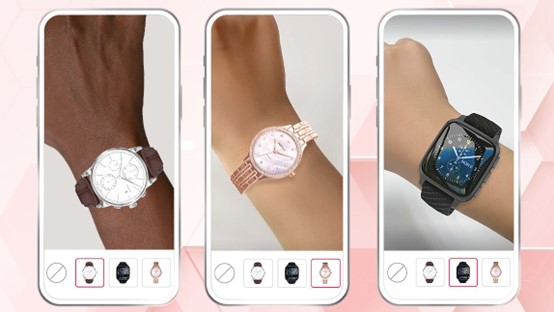
In-store Smart Mirrors
In the U.S. and UK, about a quarter of shoppers have felt unsafe while shopping in stores during the COVID-19. Retailers have to rethink the in-store experience to get customers back, and smart mirrors are one of the safest options. Fortune Business Insights reports the market value of virtual fitting rooms is expected to increase from $2.4 billion today to $10 billion by 2027. Snapchat also says that about a fifth of consumers go out of their way to stores with smart mirrors and interactive screens. It means that virtual AR mirrors will become increasingly important.
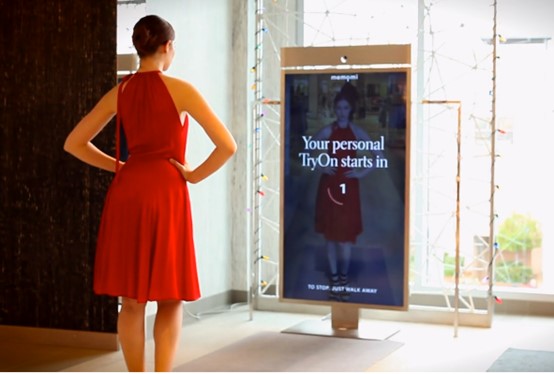
2. Wearable NFTs: Bring Your Digital Collectibles to Real Life
Would you really buy an NFT if the real world couldn’t see it? Bringing digital collectibles to real life has become an emerging trend, according to David Cash, blockchain advisor and curator at Decentraland Foundation. AR NFT allows consumers to not only wear fashion, but also interact with it in the real world. Some of the world’s biggest fashion companies are keen to use it to market their businesses. For instance, Burberry created branded wearable NFT for Mythical Games’ Blankos Block Party. Dolce & Gabbana released “Collezione Genesi”, an AR wearable NFT collection that netted nearly $6 million.
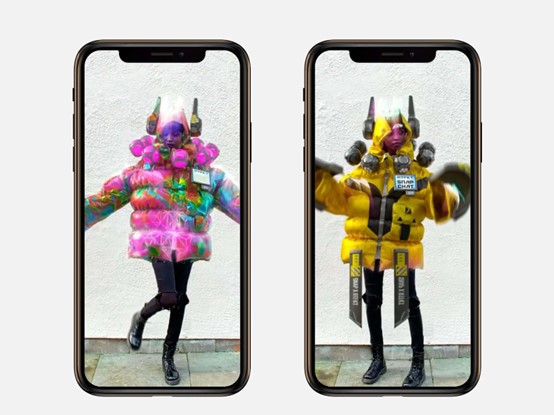
Wearable NFTs are pieces of virtual clothing or digital accessories such as limited-edition sneakers, dresses, shirts, or bags that can make your virtual avatar be a fashionista. These are made possible through blockchain technology and smart contracts, proving the uniqueness, authenticity and ownership of each garment. It creates digital scarcity while promoting numerous benefits. By some estimates, it could reach $56 billion by 2030. We can expect more brands to launch AR NFTs in 2023 as the metaverse gets closer to reality.
3. Latest Augmented Reality Future Trends in Automotive Industry
AR in the automotive industry is expected to be worth $673 billion by 2025. A number of automakers are investing in AR in new cars. Porsche invested $80 million in AR windshield technology. Tesla Motors has also demonstrated the possibilities of AR on the road. Drivers can see how the vehicle’s advanced camera suite continuously analyzes the world around them through object detection and scene analysis.

AR technology can also provide drivers with a head-up display (HUD) via headphones, accessing safety information without obstructing their field of view. The Volvo Varjo XR-1 headset is used in the proof-of-concept AR driver education system, helping drivers react defensively to obstacles that appear on the road.
Augmented Reality future trends will also be a Gen Z marketing game-changer in 2023. Users can view a 3D car model in the driveway to check details, change colors, and even watch it move around. Furthemore, users can enjoy virtual test drives in showrooms. Fast-forward to 2030 or even 2040, you may even have your own in-car AR personal assistant that can handle all the chores while you stream your favorite movie.
4. Augmented Reality Is Reshaping the Online Furniture Industry
ReAnIn reported that the global online furniture market was valued at $96.4 billion in 2021 and is expected to reach $261.8 billion by 2028, growing at a CAGR of 15.3%. Thanks to new technologies like AR, 3D rendering and computer vision, the furniture industry is undergoing a rapid wave of digital transformation. According to Statistics, 60% of online customers in the United States like exploring 3D furniture before buying. Furniture World also reported a 600% increase in AR usage, a 150% growth in conversions, and a 25% decrease in returns through their customers’ websites. Top brands like IKEA, Wayfair, Target, and Houzz are all driving more sales with AR furniture placement.
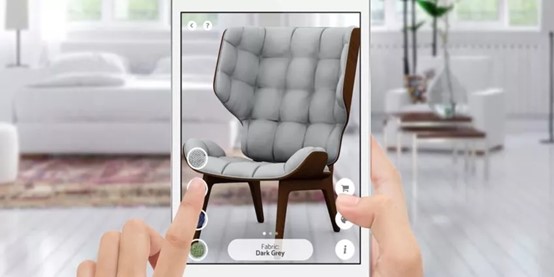
In simple terms, AR in the furniture industry provides consumers with try-before-you-buy shopping experiences through product visualizations. Shoppers can point their devices at any space in their home or office and select the item they want to place there. Hyper-realistic 3D models will be superimposed onto their real-life surroundings. They can play with its colors and patterns or move it around to gauge style, fit and size.
5. Enhance Marketing Campaigns with Digital Human
The global digital human avatar market size is expected to reach $527.58 billion by 2030, registering a revenue CAGR of 46.4%, according to Emergen Research. Because of the better reliability of digital human influencers in achieving intended goals, many companies are pouring money into marketing campaigns. As more virtual influencers emerge, such as Noonoouri, Imma, Lil Miquela, etc., various industries are eager to embrace them to embody the personality and voice of the brand, and boost omni-channel sales.

The application of digital humans in AR technology will be one of the popular trends in the metaverse. They can seamlessly transition across multiple environments, from Instagram posts to video games. With SLAM World tracking, consumers can also place digital models in the real world. Virtual Imma has been chosen as the ambassador of Watsons’ new carbonated drink, X Soda. In this case, consumers can freely immerse themselves in mysterious space-time signals and build deep emotional connections with the brand.
6. Augmented Reality Smart Glasses- Worth $17.72 Bn by 2025
Smart glasses are rapidly becoming one of the most exciting new augmented reality future trends in 2024. The smart eyewear market will be potentially worth $17.72 billion by 2025, and it’s attracting the attention of a variety of tech market leaders from Apple to Meta. One of the latest devices to come out is Meta’s planned mixed reality headset, called Cambria, a new product line that is different from their Meta Quest 2. Apple is also expected to launch consumer-focused AR headset or glasses in the future.
TIPS
Check ou more limited-time offers on Amazon: Amazon Prime Day: Top 15 Picks at 50% OFF in 2024
Higher quality glasses displays have long been a focus for AR hardware creators. Innovators in the A/V space have introduced a range of products ranging from micro displays to ultra-thin lenses for the glasses of the future. We should expect future smart glasses with displays that are lighter than ever and capable of delivering high-fidelity images.
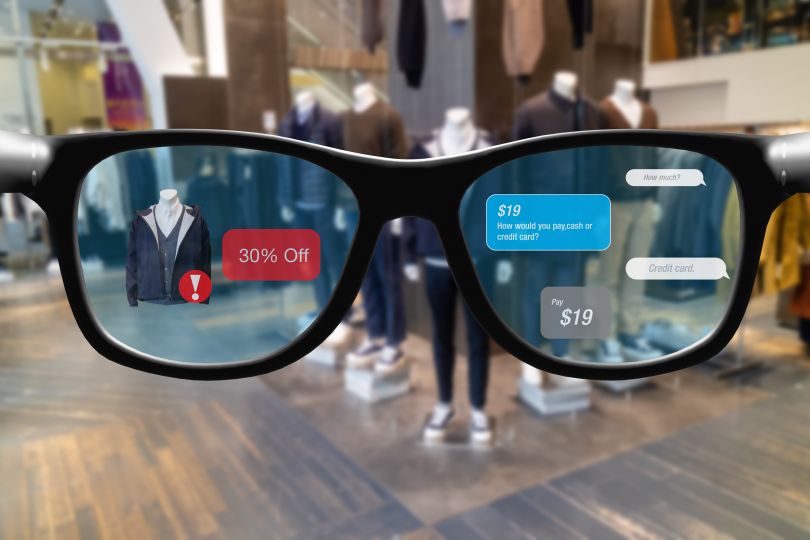
These devices, designed to merge the digital and physical worlds seamlessly, will witness substantial advancements in technology, aesthetics, and usability, driving their adoption across diverse sectors.
Technological Advancements: Smart glasses in 2024 will boast cutting-edge optical displays, capable of rendering high-resolution imagery directly into the wearer’s field of view. The embedded processors will be faster, supporting complex algorithms that render realistic 3D graphics and animations. Moreover, advancements in batteries and wireless charging will ensure longer battery life and reduced downtime.
Design and Comfort: Fashion and form factor will no longer be sacrificed for function. Smart glasses will adopt sleeker, lightweight designs that resemble conventional eyewear, appealing to style-conscious consumers. Improved ergonomics, adjustable frames, and customizable options will ensure a comfortable fit for extended periods, whether at work or leisure.
Interoperability and Connectivity: Seamless integration with smartphones, IoT devices, and cloud services will allow smart glasses to serve as a central hub for managing and interacting with digital content. Features like voice commands, gesture recognition, and eye-tracking will provide intuitive ways to navigate through menus, control smart homes, and communicate with others.
7. Augmented Reality in Healthcare – Value at $4.64 Bn by 2025
The North American healthcare AR and VR industry is expected to grow dramatically to $4.64 billion by 2025. With AR, doctors and professionals can provide patients with the best health care. AR has been used in education for patients and physicians, as well as simulation of surgery and disease. AccuVein uses projection-based AR to scan the patient’s body and show the doctor the exact location of the vein. It increases the injection of the vein on the first stick by 3.5 times and reduces the need for assistance by 45%.

With the restriction of COVID-19, AR is becoming increasingly important to address issues such as the complexity of remote patient support and increased burden on hospitals.
8. AR Live Shopping Will Seize the West
Imagine TV shopping, such as HSN, QVC, etc., done over the Internet, with products and their features highlighted and purchased with a click. It’s modern live shopping, which naturally combines with elements like AR try-on. The following three advantages make it so popular.
- Combines the convenience of online shopping with the personal touch of the in-store shopping experience
- Allows companies with a significant social media presence to turn subscribers into customers without leaving the platform
- Easy integration of influencer marketing

On Instagram, 44% of weekly users shop on the live streaming platform. This is where it outperforms TikTok, as users generally see Instagram as a more convenient option. Overall, annual live shopping sales are expected to reach $25B in the U.S. alone by 2023. By 2026, they could account for 20% of all e-commerce sales there.
9. Visual Content is Driving the Future of AR Gaming
When users talk about augmented reality gaming, the first thing that probably comes to their minds is the hugely popular Pokemon Go. Since the release of AR kits from Google and Apple, developers have continued to create games with AR elements in the hope of replicating the success of Pokemon Go. AR gaming has become popular among gamers. According to Verified Market Research, this industry is set to reach $31.7 billion in revenues by 2028, representing a compound annual growth rate of 21.98%. This interactive visual content is driving the future of augmented reality gaming market.
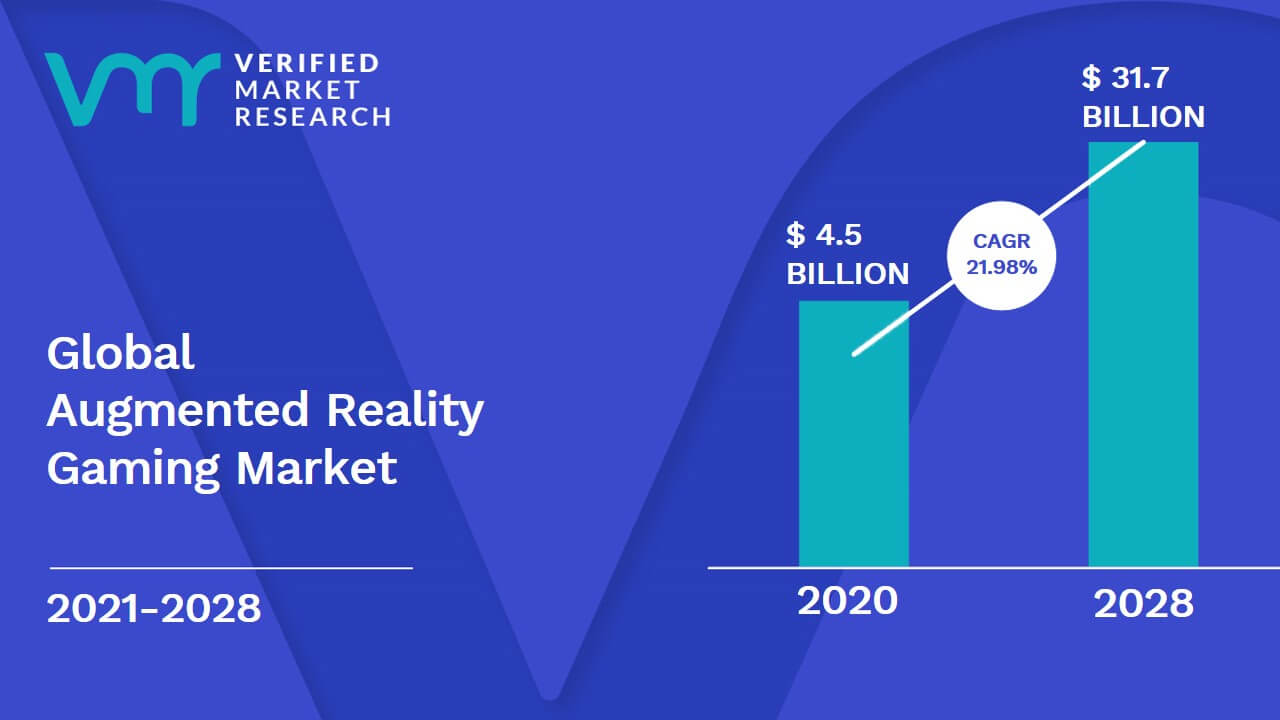
These numbers are likely to continue to rise in the near future due to the increasing availability and accessibility of AR technology, including more integration of AR into mobile devices, and many innovations in the gaming community that can easily accommodate AR technology. We can expect to see more mobile AR games on the market, including Temple Treasure Hunt, Sharks in the Park, WallaMe, and more.
In addition, based on geography, the global augmented reality gaming market is divided into North America, Europe, Asia-Pacific, and the Rest of the world. North America is expected to become the world’s leading AR gaming market in the overall gaming business. This growth has been driven by rising consumer disposable income and constant technological innovation. Globally, factors such as AR or VR technological breakthroughs are foreseen to drive the huge growth of this market.
10. 5G Accelerates the Growth of AR/VR Trends
The widespread deployment of 5G networks has accelerated the adoption of AR. The industry analysts confirmed that 5G will provide a promising approach to regional applications and the future of AR. By integrating AR with 5G, users can get a better experience in terms of low-end delay times, as 5G can improve cloud transmission and processing speeds, and provide a more stable connection to create better virtual images.

11. Environmental Awareness & Sustainability Leveraging Augmented Reality
In the realm of environmental stewardship and sustainability, augmented reality emerges as a powerful tool to engage, inform, and inspire change. By 2024, AR applications are anticipated to play an instrumental role in promoting green initiatives and educating the masses about the importance of conservation and sustainable living.
Visualizing Impact: One of the most compelling aspects of AR in this context is its ability to bring abstract concepts to life. For instance, AR apps could project the visual impact of pollution, climate change, or habitat destruction over time onto real-world locations. Users might point their smartphones or AR glasses at a local park or beach and see, in vivid detail, the potential consequences of unchecked environmental degradation or conversely, the regenerative effects of conservation efforts.
Educational Outreach: Educational institutions and NGOs could employ AR to create interactive learning experiences that teach about ecosystems, biodiversity, and renewable energy sources. These experiences might include virtual tours of rainforests, coral reefs, or solar/wind farms, where learners can interact with virtual flora and fauna or explore the inner workings of clean energy technology.
Resource Management Tools: In urban planning and architecture, AR can facilitate the design and implementation of green infrastructure projects. Architects and city planners could utilize AR to simulate green spaces, assess water runoff patterns, or demonstrate the effectiveness of energy-efficient building designs, helping stakeholders understand and appreciate the long-term benefits.
Waste Management & Recycling: AR can also aid in making recycling and waste disposal more efficient and understandable. An AR application might guide users on proper recycling procedures by identifying materials and showing the appropriate bin to place them in, or it could highlight nearby recycling facilities and display statistics on waste reduction progress.
12. AR Integration in Social Media Platforms
In the coming years, particularly by 2024, social media platforms are expected to incorporate augmented reality (AR) functionalities to an extent that was once considered futuristic. This integration will significantly transform the way users engage with content, communicate with friends, and express themselves online.
Immersive Sharing Experiences: Users will be empowered to capture and share their moments in a much more engaging manner. Instead of posting static images or videos, AR-integrated social media apps will let users create and share immersive experiences. Imagine capturing a sunset and then being able to share it as a 3D postcard that allows your friends to virtually visit the scene you’ve captured. Or perhaps recording a dance performance that can be relived in augmented reality, where viewers can move around the dancers as if they were there.
Customizable Personal Filters and Avatars: With AR, social media profiles will take on new dimensions. Users will have access to a vast array of personalized filters that go beyond simple face masks. These filters could change the background, add virtual props, or even morph users into entirely different avatars in real-time. The level of customization will be unprecedented, allowing individuals to truly express their creativity and personality through their digital personas.
Collaborative Virtual Environments: Social interactions on these platforms will transcend geographical barriers. Friends can join together in shared virtual spaces, attending virtual parties, playing games, or collaborating on projects. AR technology will enable users to co-create and interact in a unified, three-dimensional environment, fostering a sense of togetherness despite physical distance. For instance, groups of friends could gather in a virtual room, decorate it collaboratively, and interact with each other’s virtual representations in real-time.
Augmented Reality Trends Play a Role in Digital Transformation
Companies seeking to accelerate business growth and other key metrics like conversion rates, retention rates, and margins will see measurable gains from digital transformation. AR is demonstrating business benefits, from helping increase productivity to connecting with customers in digital ways for sales growth. It can also help companies reduce costs and improve their environmental credentials.
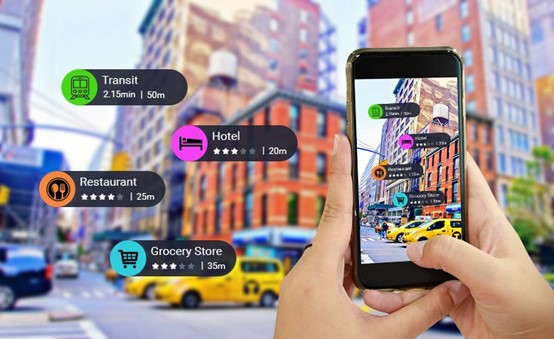
In the next few decades, advances in AR and immersive technology will significantly improve our lives. Our means of interacting with digital information will no longer be hardware or screens, but more emotions and gestures in the future. We will see a rise in the adoption of AR across various industries, such as fashion, automotive and retail markets.
Bottom Line
Augmented reality is still far from its peak, as innovations happen almost every week, and more businesses are turning to it. Moreover, WebAR can be accessed through a browser, meaning it can run on almost any connected device. Industrial AR, used through smart glasses, will also become increasingly popular among large manufacturers and government organizations. The augmented reality trends are expected to be one of the most influential technologies in 2024 and beyond.

![How to Mint NFT without Gas Fee in 3 Ways 2023 [Gasless NFT Minting]](https://artechtips.com/wp-content/uploads/2022/09/How-to-Mint-an-NFT-for-Free-300x169.jpg)
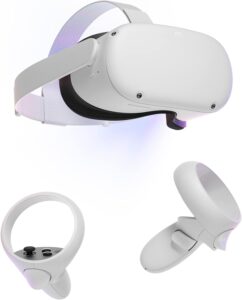



[…] the augmented reality trends surging ahead, Apple has been investing heavily in this technology, and iOS 17 is expected to bring […]